Fall in Colorado isn’t just about the changing colors of the aspen trees. It’s also a season where gardens come alive with bright colors with gorgeous fall-blooming flowers. In this transition, before the snow blankets the ground, several different flowers take the spotlight, adding a spectrum of colors from the softest pastels to the most vivid reds, oranges, and purples. This article will guide you through some of the most colorful fall-blooming flowers that thrive in Colorado’s unique climate. Each flower not only adds a splash of color but also brings its own unique charm to any garden.
1. Red Spider Zinnia (Zinnia tenuifolia)
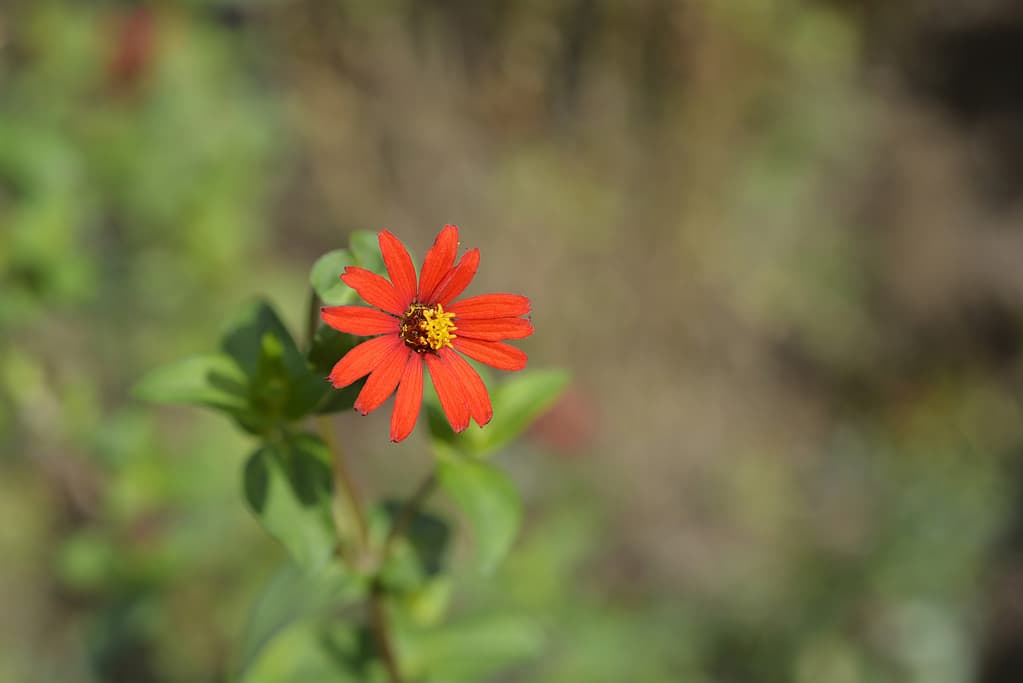
The red spider zinnia is a fall-blooming plant that boasts daisy-like red flowers and can thrive in Colorado.
©Nahhan/iStock via Getty Images
First on the list of fall-blooming flowers in Colorado is the red spider zinnia. It is a small, structured annual plant known for its abundance of unique, daisy-resembling flowers. These flowers, measuring about an inch across, showcase slender, spider-like petals. They adorn the garden from summer through fall, perched on delicate stems above a bed of lance-shaped green leaves.
This charming zinnia variety draws bees, butterflies, hummingbirds, and other pollinators, making it a delightful addition to sunny borders or patio containers. It’s well-suited for a variety of garden settings, including beds and borders, cottage gardens, urban gardens, wildlife gardens, and pollinator gardens.
The red spider zinnia reaches a height of 24 to 30 inches and spreads about 12 to 18 inches wide.
Growing Tips
- Thrives in full sun exposure with a preference for humus-rich, well-drained, fertile soil.
- Adaptable to different soil types. However, it’s important to avoid wet, poorly aerated soils as they could lead to root rot.
2. Western Vervain (Verbena lasiostachys)
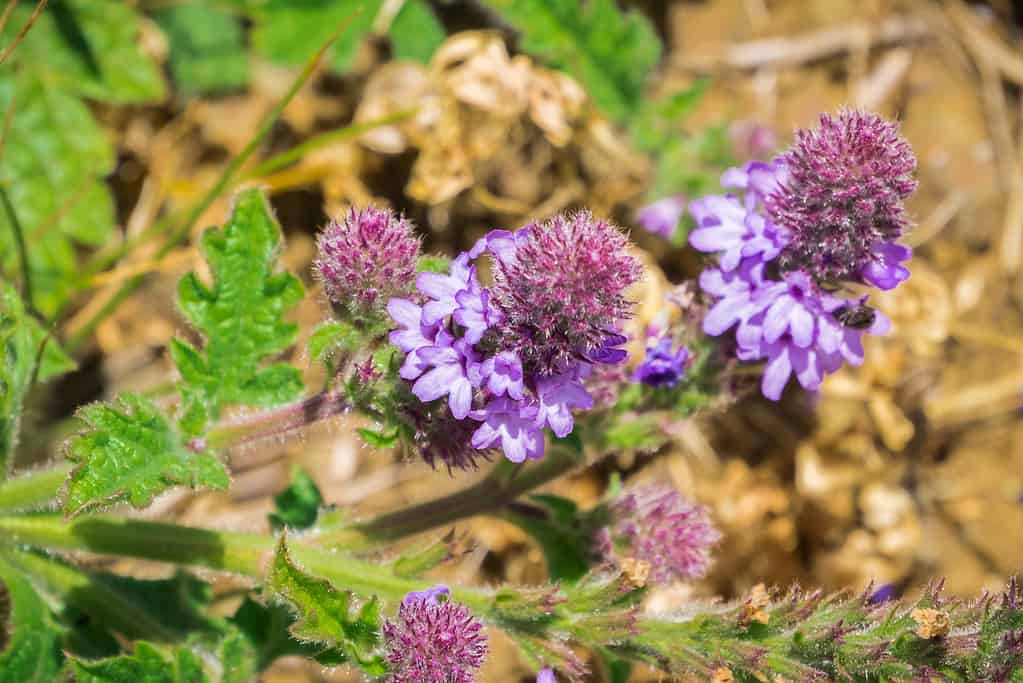
The western vervain is a fall-blooming flower that may spread aggressively in moist conditions.
©Sundry Photography/iStock via Getty Images
Known for its extended blooming period, from spring to fall, the western vervain is a sprawling perennial or sub-shrub. This plant features purple-to-blue, slender flower spikes stretching 3 to 10 inches long atop its thin, wiry stems. Its blossoms unveil themselves from mid-spring to fall, providing a durable display of colors for weeks to months.
During winter, the western vervain enters a complete dormancy, but as early spring arrives, it grows rapidly. Originating from western North America, this plant tends to spread aggressively, especially in moist conditions. Hence, it’s advisable to plant it in areas where it can be observed and controlled. It finds its use in preventing soil erosion and in attracting hummingbirds and butterflies to gardens.
The western vervain typically grows to a height of 2 to 3 feet and spreads out about 3 feet wide.
Growing Tips
- Prefers full sun exposure and can adapt to a range of well-drained soil types, including sand and clay, provided there’s sufficient moisture.
- Demonstrates drought tolerance and can also withstand seasonal flooding.
3. Homestead Purple (Verbena canadensis)

The homestead purple is a type of award-winning
Verbenathat is a big hit for fall-blooming flower gardens.
©Danita Delimont/Shutterstock.com
Adorning the garden from late spring until frost, the award-winning Verbena ‘homestead purple’ is a highly regarded flowering plant for its relentless display of bright purple flower clusters. The plant’s shiny, dark green leaves beautifully contrast the slightly fragrant purple flower heads, enhancing its appeal.
This Verbena variety is a fantastic choice for bordering or rock gardens, and when planted in large numbers, it creates an eye-catching effect. Besides being a charming ground cover, it’s also suitable for edging and fits well in containers or hanging baskets.
It grows to a modest height of 1 foot while spreading energetically up to 3 feet wide.
Growing Tips
- Flourishes in full sun and prefers average, dry to medium, well-drained soils. Under favorable growing conditions, it has the ability to self-seed.
- Tends to perform better in average to poor soil rather than in rich, moist garden soil. Providing excellent drainage is a key factor for its growth.
4. Signet Marigold (Tagetes tenuifolia)
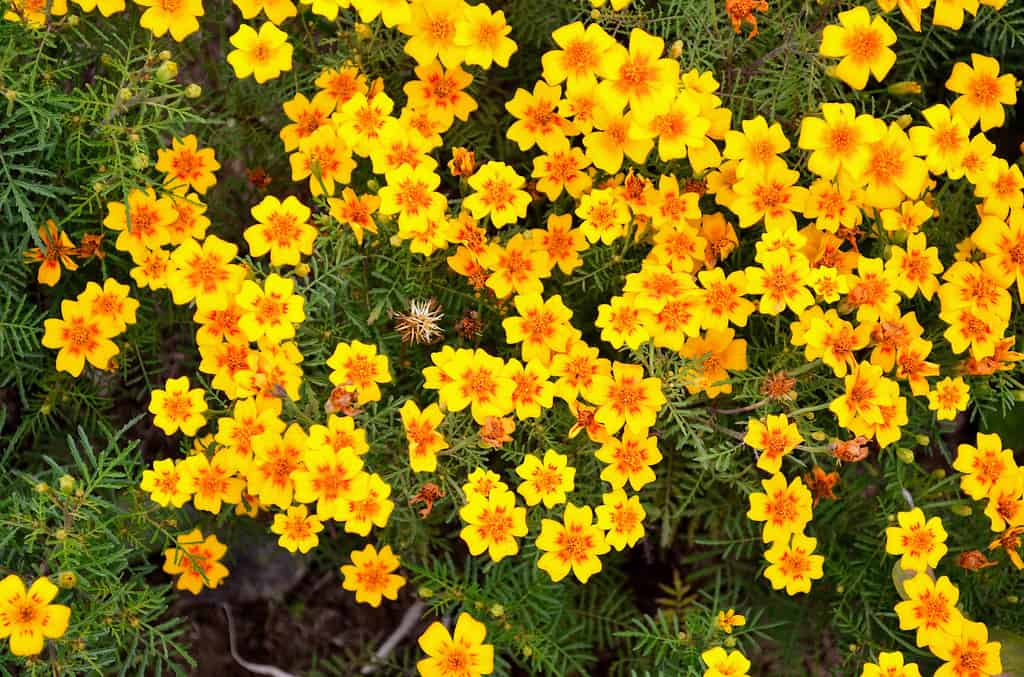
A fall-blooming flower that is perfect for Colorado gardens is the signet marigold, which boasts tiny but gorgeous and lemony flowers.
©Bhupinder Bagga/iStock via Getty Images
The signet marigold is a captivating fall-blooming option with its single flowers that, although small, are incredibly plentiful and rich in color, generously adorning the finely cut lacy foliage. This compact and bushy annual is a relentless bloomer, gracing the garden with its presence from early summer all the way to frost!
An interesting fact is that both the flowers and the leaves carry a delightful scent. The light touch of your fingers can release a refreshing, lemony aroma as you stroll by. Planting signet marigolds in your garden as bedding or edging plants, especially at the front of borders or in containers on your deck or patio, can significantly enhance the aesthetic appeal of your outdoor space.
This plant reaches a height and spread of up to 12 inches, making it a compact yet prolific bloomer.
Growing Tips
- Thrives in full sun with a preference for average, consistently moist, well-drained soil conditions. In regions with hot summers, a bit of light shade is tolerable.
- It’s advisable to avoid rich, fertile soils as they can lead to weaker, more floppy marigolds with reduced blooming.
5. Mexican Sunflower (Tithonia rotundifolia)

The Mexican sunflower is a hearty grower that boasts flowers that last for weeks.
©Doikanoy/Shutterstock.com
Basking in the summer warmth, the Mexican sunflower is a heat-loving annual that produces daisy-like flowers. These blooms stretch up to 3 inches across, adorned in shades of bright orange and yellow from midsummer to fall. Its lively and plentiful blossoms that last for weeks make this robust fall-blooming plant a visual treat to the garden.
Plant this elegant and lively plant into your garden, and you’ll find yourself amidst a bustling crowd of butterflies, bees, hummingbirds, and other beneficial pollinators and insects.
This hearty grower reaches 4 to 6 feet in height and spreads out to a width of 2 to 3 feet.
Growing Tips
- Ideally suited for full sun exposure, thriving in average, dry to medium moisture, well-drained soil conditions.
- While it can endure dry and poor soils, it’s wise to steer clear of rich, fertile soils as this could lead to excessive foliage.
6. Stokes’ Aster (Stokesia laevis)
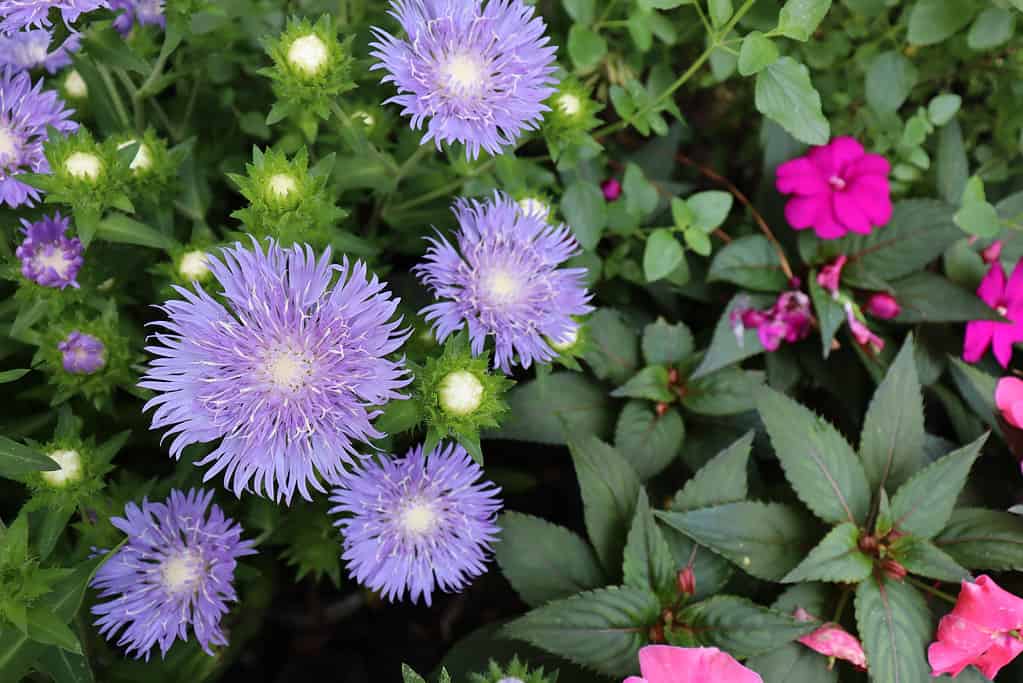
Another fall-blooming flower you should think about planting in your Colorado garden is the Stokes’ aster.
©iStock.com/Wirestock
The Stokes’ aster is a modest-sized, semi-evergreen perennial that forms a base rosette of lance-shaped, dark green leaves, each around 6 inches long. From late spring to fall, it showcases a bounty of large, violet-blue flowers resembling cornflowers. Each bloom spans 3 to 4 inches across, standing tall on stiff, leafy stems.
In favorable conditions, stokes aster is known to self-sow in the garden. Being hassle-free and easy to grow, this eye-pleasing perennial is an ideal choice for borders or cottage gardens. Moreover, it serves as a low-maintenance groundcover, adding a floral charm to the area.
This plant reaches a height of 12 to 24 inches and spreads around 12 to 18 inches wide.
Growing Tips
- Prefers full sun and prospers in light, fertile, slightly acidic to neutral, moist, well-draining soils.
- Although it can handle a bit of shade, it performs best in full sun. Once established, it shows a good degree of drought tolerance.
7. Blackfoot Daisy (Melampodium leucanthum)

The blackfoot daisy is a perennial that boasts white daisies that measure around an inch across.
©Wonderplay/Shutterstock.com
Well-known for its extended blooming period, the blackfoot daisy is a resilient perennial that forms a low, dense mound with narrow gray-green leaves and sweet-smelling, white daisies measuring about an inch across. These flowers bear a resemblance to white zinnias, with each flower head displaying 8 to 13 wide white rays, notable for the unique notches at their tips, encircling a small yellow center.
The blackfoot daisy is a fitting choice for sunny rock gardens, border areas, and containers, making it an exemplary species for water-conserving or xeric gardens. While it may have a shorter lifespan, the blackfoot daisy has a knack for self-seeding!
This plant achieves a height of 6 to 12 inches and spreads out 12 to 24 inches wide.
Growing Tips
- Flourishes in full sun or partial shade, favoring rocky, gravelly, sandy, acidic, dry, and well-draining soil conditions. Ensuring good soil drainage is crucial.
- It’s best to avoid rich soil and excessive watering as they may reduce the plant’s lifespan.
8. Colorado Four O’Clock (Mirabilis multiflora)

Interestingly, the Colorado four o-clock is a fall-blooming flower that unfolds in the afternoon and closes back up in the morning.
©WeiseMaxHelloween/iStock via Getty Images
Another fall-blooming flower with a long blooming period, the Colorado four o’clock is a robust perennial with a sprawling and dense demeanor. This flowering plant presents a multitude of fragrant, lively, deep pink, broad tubular blooms from spring to fall.
These large flowers, stretching up to 2 inches long, sprout in the leaf joints and in clusters at the ends of the many slender yet branched stems. The flowers unveil their beauty in the afternoon and close as morning arrives.
Ideally positioned along walkways or close to patios, this plant’s evening-blooming flowers and delightful aroma enhance your outdoor space. While it dies during frosty winters, it re-emerges from its sizable tuberous roots in the spring!
This plant reaches a modest height of 1 to 2 feet but spreads out generously between 3 and 5 feet wide.
Growing Tips
- Thrives in full sun to light shade, favoring dry or rocky, well-drained soil conditions.
- With a knack for drought tolerance, it’s well-suited for dry, desert-like environments, making it a low-maintenance choice for such landscapes.
9. Macedonian Scabious (Knautia macedonica)
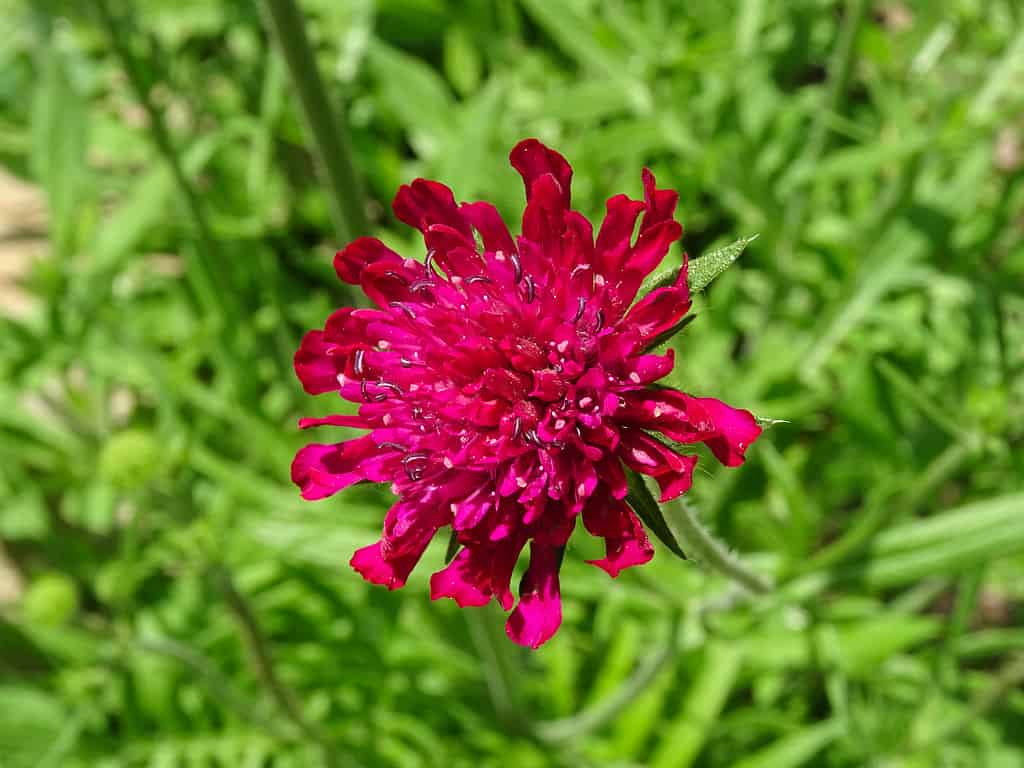
The Macedonian scabious is a gorgeous fall-blooming flower that can thrive in Colorado.
©Carlos Rodriguez/iStock via Getty Images
Easy to grow, the Macedonian scabious is a perennial that forms clumps and showers the garden with abundant deep crimson, pincushion-like flowers. These flowers measure 1.5 inches across and continuously bloom from early summer to fall. These blooms are a magnet for butterflies, perched on slim, branching stems with scarcely lobed leaves near the base but more intricately divided leaves further up.
Though it may have a shorter lifespan, under favorable conditions, it tends to self-seed, ensuring its presence in the garden. This light and airy perennial especially thrives in regions with cooler summer evenings.
It grows uprightly, forming clumps, reaching a height of 18 to 36 inches and spreading 18 to 24 inches wide.
Growing Tips
- Flourishes in medium moisture, moderately fertile, well-drained soils under full sun exposure. Has a preference for neutral to alkaline soil conditions.
- A sheltered spot is ideal for its growth. It’s noteworthy for its drought tolerance and resistance to deer.
10. Musk Mallow (Malva moschata)

Blooming from early summer to fall, the musk mallow is a tall perennial that boasts pink flowers that have a lovely musky scent.
©yujie chen/iStock via Getty Images
The musk mallow is a tall, branching perennial known for its light pink, saucer-sized flowers with a musky scent. These blooms measure 2.5 inches across and grace the garden over an extended blooming season. From early summer to fall, these eye-catching flowers appear either singly or in clusters nestled in the leaf joints, attracting a variety of insects and butterflies.
The foliage, finely cut, carries the same musk fragrance, especially when touched or brushed against. Musk mallow is a great addition to cottage or wildflower gardens, where its subtle elegance can be admired.
This plant grows to a height of 2 to 3 feet and spreads between 18 and 24 inches wide.
Growing Tips
- Thrives in full sun exposure with average, medium moisture, well-drained soil conditions.
- Prefers cooler climates and may not perform best in hot and humid summers.
11. White Gaura (Oenothera lindheimeri)
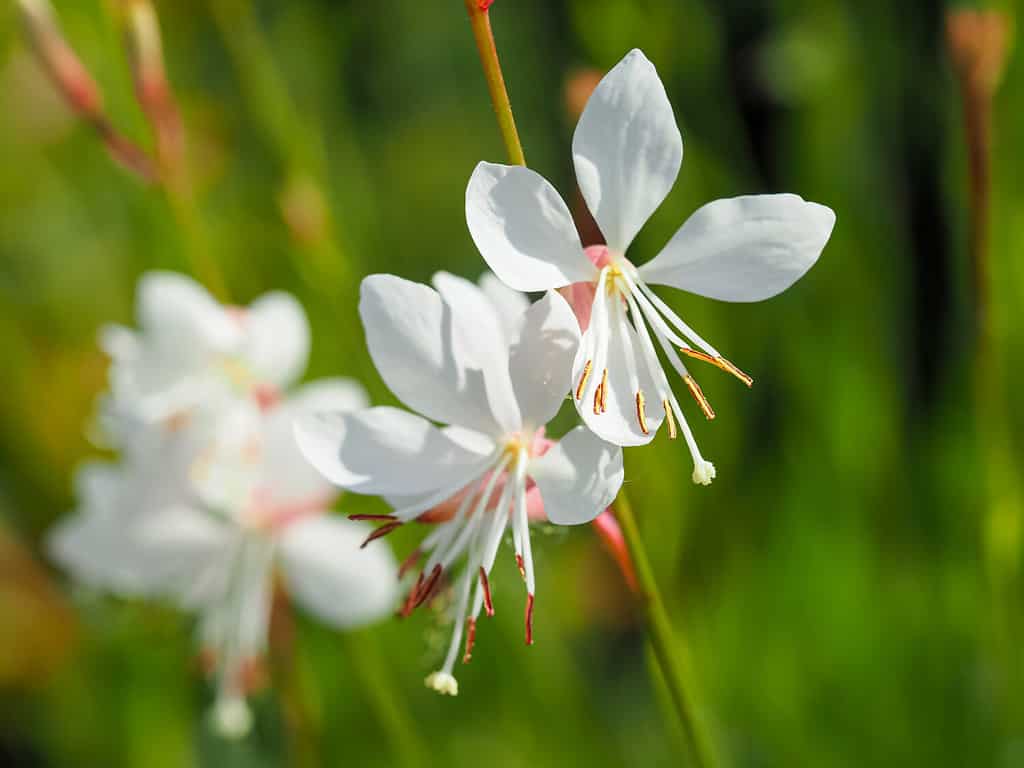
Another fall-blooming flower in Colorado is the white gaura, which has a lengthy blooming season from early summer to fall.
©AngieC333/Shutterstock.com
The white gaura is a charming perennial plant characterized by its tall, delicate flowers that resemble butterflies fluttering in the garden. Its unique texture is displayed through its 4-petaled, pink-colored or white, 1-inch-long flowers situated atop slender spikes.
Known for its lengthy blooming season, gaura brings joy from early summer all the way into fall. While only a few flowers bloom at a time, they unveil themselves in ample quantity to exhibit a graceful display lasting for weeks.
Honored with the esteemed Award of Garden Merit by the Royal Horticultural Society, the white gaura grows in vase-shaped clumps, standing 2 to 4 feet tall and spreading 2 to 3 feet wide.
Growing Tips
- A lover of full sun, white gaura prospers in sandy, loamy, well-drained soils, showing remarkable drought resistance.
- It also holds up well against heat, humidity, partial shade, and dry soil conditions.
12. Red Feathers (Echium amoenum)
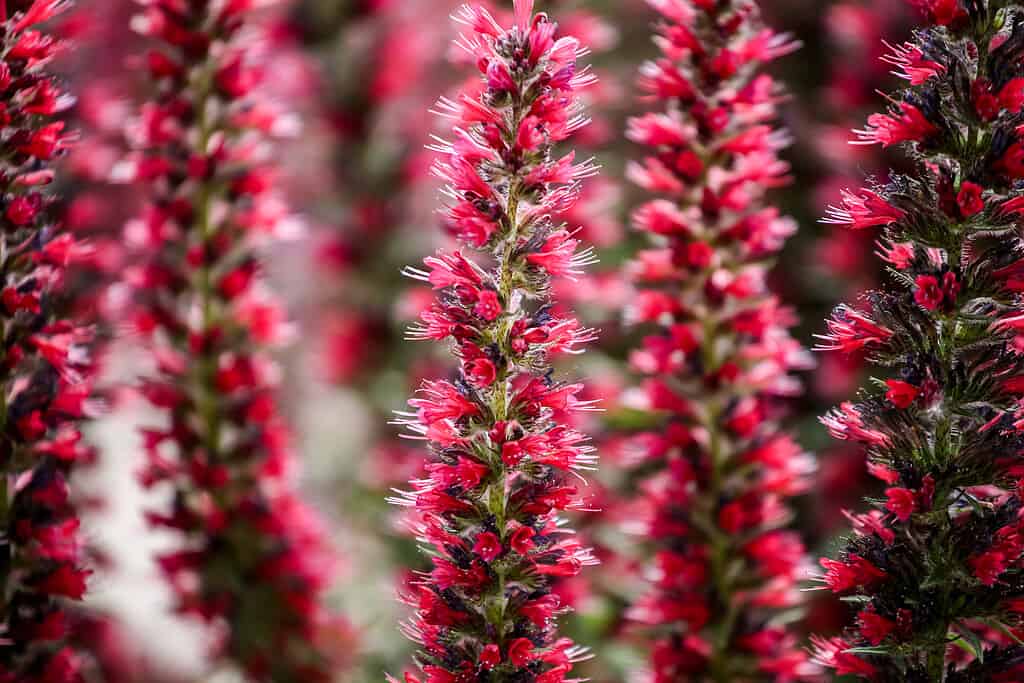
A favorite among hummingbirds, bees, and butterflies, the red feathers is another fall-blooming flower you can plant in Colorado.
©boggy22/iStock via Getty Images
Red feathers is a short-lived perennial, forming a neat clump of fuzzy lance-shaped leaves. From late spring to frost, it showcases russet-red flower spikes. By removing faded flower spikes, you can encourage new ones to sprout, prolonging the plant’s blooming season.
Post flowering, red feathers produce seed and reach the end of its life cycle. Yet, it has a knack for self-seeding, ensuring its presence in the garden continues. The red feathers is appealing to hummingbirds, bees, and butterflies while being resistant to deer.
This plant grows to a modest height of 10 to 14 inches and spreads 6 to 8 inches wide.
Growing Tips
- Best suited to full sun or partial shade, thriving in dry to medium, well-drained soil conditions.
- Once settled, it exhibits drought tolerance, adding to its low-maintenance appeal.
Summary of the Most Colorful Fall-Blooming Flowers in Colorado
| Number | Flower | Blooming Period |
|---|---|---|
| 1. | Red Spider Zinnia | Summer to fall |
| 2. | Western Vervain | Mid-spring to fall |
| 3. | Homestead Purple | Spring to frost |
| 4. | Signet Marigold | Early summer to fall |
| 5. | Mexican Sunflower | Mid-summer to frost |
| 6. | Stokes Aster | Late spring to fall |
| 7. | Blackfoot Daisy | Early spring to fall |
| 8. | Colorado Four O’Clock | Spring to fall |
| 9. | Macedonian Scabious | Early summer to fall |
| 10. | Musk Mallow | Early summer to fall |
| 11. | White Gaura | Early summer to fall |
| 12. | Red Feathers | Late spring to frost |
The photo featured at the top of this post is © boggy22/iStock via Getty Images
Thank you for reading! Have some feedback for us? Contact the AZ Animals editorial team.







